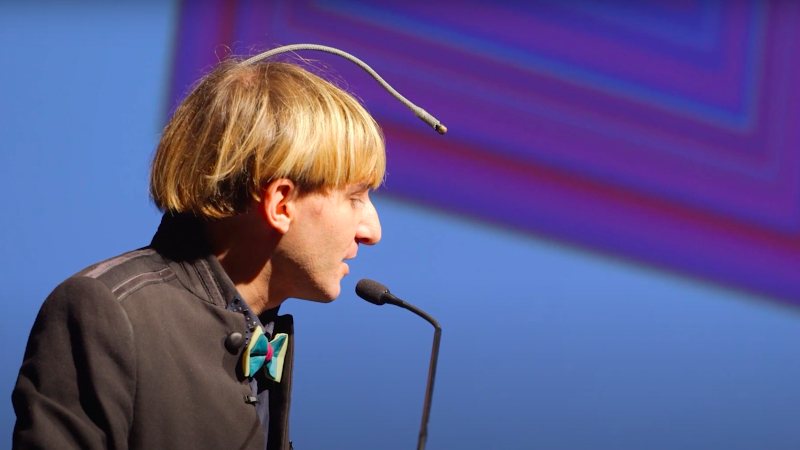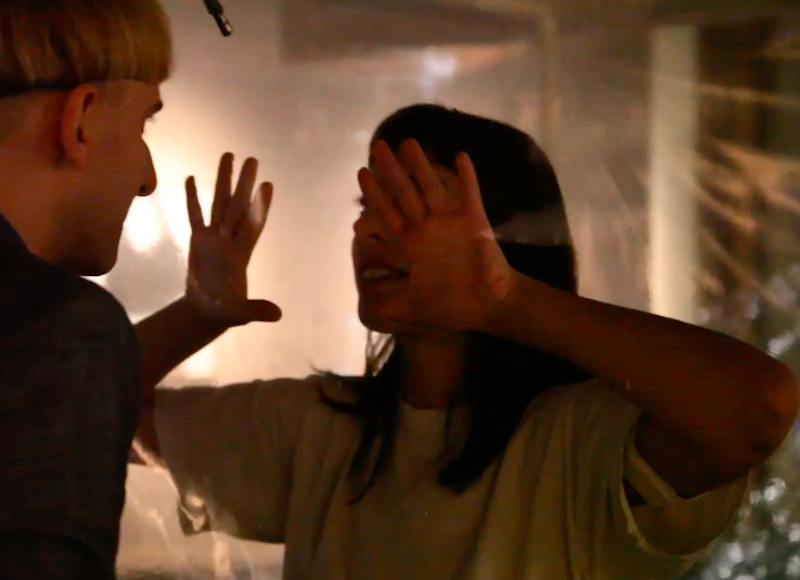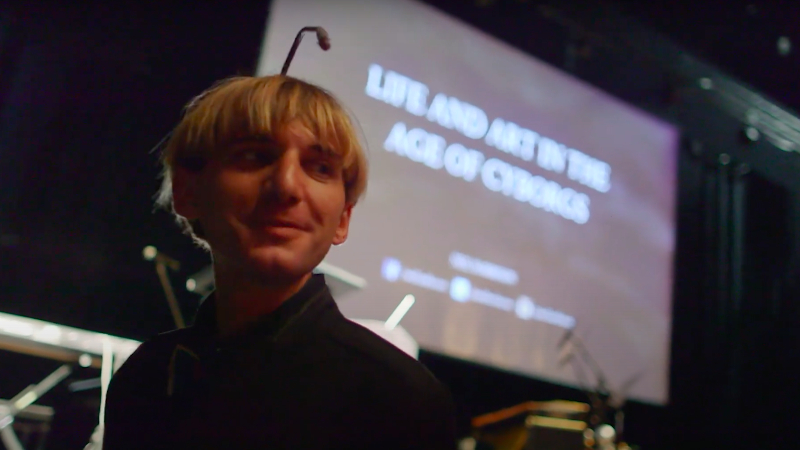Director – Carey Born – 2023 – Germany, Spain, UK – Cert. 12a – 87m
***1/2
Cyborg artist Neil Harbisson, unable to see in colour, has had an antenna implanted in his head to hear colours instead – out in UK cinemas on Friday, September 20th
This opens with a title sequence of weird, psychedelic images of what appears to be moving coloured liquids forming strange, never to be repeated natural patterns. If that implies a striking visual sensibility, that’s deceptive, since this documentary follows a fairly straightforward structure of following people around with cameras and talking to them as it introduces us to cyber artist Neil Harbisson and his artist partner Moon Ribas.
Neil stands out from other people because he has an antenna protruding from the back of his head to dangle in front of his forehead. He was born with the unusual condition of achromatism, which means that he sees not in colour but in monochrome. (Less severe, more common forms of colour blindness include the inability to differentiate between green and red.) This came to light in his childhood when the family got a new colour TV, and he and his sister would watch cartoons. At this point, the film throws in a clip of the children’s sci-fi cartoon series Robotrix (John Gibbs, Terry Lennon, 1985). “She could see things that I couldn’t”, says Harbisson. Shortly after this, another clip, in black and white, shows the creation of the robot Maria from Metropolis (Fritz Lang, 1927).

His life changed when he met hardware technician Adam Montandon who liked building low-tech devices, and made him an ‘eye-borg’, a pair of headphones with an antenna attached that could produce sounds from light waves, interpreting the different frequencies of different colours as sounds. (Cue a clip of the creation of the monster from Frankenstein, James Whale, 1931.) Neil wanted to have the device permanently implanted into his head, as the ability to take it on and off meant it wasn’t like a permanent sense, in the way that eyes or ears are.
However, his local hospital, after much consideration, refused him the operation, which involved drilling into his head, on the grounds that this would be unethical. They nevertheless put him on to a doctor who was prepared to carry it out. For the first five or so months after, he experienced headaches, but then his brain adjusted to the new sense.
When asked his favourite colour today, Neil responds, “infra-red”, demonstrating that his sensory equipment – his senses, if you will – can take in colours outside the range of most human senses. As he explains here, the colour red is the lowest frequency, while violet is the highest. At the University of London’s Centre for the Study of the Senses, he explains that if everyone had the same sensory facility that he now possesses, when they went to the beach they would hear the ultraviolet, and consequently wouldn’t lie down in it.
Colour comprises three components. Hue he experiences as something like musical notes, saturation is denoted by volume, and light is something he can see. He shows us two paintings consisting of a series of concentric, coloured rectangular outlines within the painting frame. Both are base on speeches, one based on hope by Martin Luther King and one based on fear by Adolf Hitler; the two images look very different in terms of colour palette.

Neil first met Moon when they met through a theatre group when he was 11, and she was eight. They got involved in a successful campaign to save some trees outside a church which were going to be cut down. As teenagers, both very much against technology, and Neil describes many firsts that he and Moon shared: the first time they got drunk, the first time they had sex, the first time they took drugs.
Since his antenna was fitted, Neil dreams in colour, something he couldn’t do previously. That said, his perception of colour is different from most people’s – not better (although he appears to perceive a wider spectrum), not worse, but different. He talks about himself as an artist who welcomes the opportunities of perceiving through new senses and expressing himself through new senses.
The more traditional and conservative-minded may be resistant to such ideas. While visiting Moon’s grandmother (the couple live in the city of Mataró, not far from Barcelona), the latter insists that “what God gave must not be touched”. Some have taken a much more confrontational approach to Neil’s implant, with one person threatening his assassination by the end of 2017. The couple is seen by such reactionaries as terrorists, going against both humanity and the will of God.
(Personally, I think you could make compelling theological arguments in favour of people adding new senses, either from the dominion over the earth perspective of the Biblical creation myth in Genesis, or from Jesus’ dictum that “man is not made for the Sabbath but the Sabbath for man” in the gospels, but sadly the film doesn’t go there.)

The film offers the clip from Orphée (Jean Cocteau, 1950) where characters enter the underworld through a mirror with optimistic and, indeed, almost religious sounding words, “you don’t have to understand, you have to believe.”
Moon talks about what attracted her to Neil: “he made me feel like everything was possible,” she says, and watching him talking and travelling around in this film, you can see exactly what she means. Moon is involved with dance, and talks about her dance piece based around the idea of waiting for earthquakes to happen, later going further in expressing a desire for a sense that would give her an awareness of when a quake was imminent. (It’s not mentioned here, but the Japanese already do this via the Japan Meteorological Agency (JMA)’s Earthquake Early Warning system, which sends high-pitched tones to smartphones when an earthquake is imminent. This is aptly illustrated in the animated feature Suzume (Makoto Shinkai, 2022). It begs whether certain smartphone apps, or other tools in common use, already effectively turn us into cyborgs, a promising line of enquiry the film sadly never takes up.)
Neil speaks of “the right to design yourself” and “the right to design the senses you have.” He lambasts novelists and filmmakers, saying it’s much easier to create stories based on fear than ones which are more optimistic and forward-looking, an analysis your current scribe would agree with. Right on cue, up pops a clip from H.G. Wells-scripted Things to Come (William Cameron Menzies, 1936) The film ends, appropriately enough, by running the song Do You Dream in Colour by forward-looking, independent British musician Bill Nelson over its end credits.
Neil Harbisson can be briefly seen in the documentary Disconnect Me (Alex Lykos, 2023), about a man attempting to live without a mobile phone, which is where I first came across him. His appearance there is, in part, what attracted me to the current film, a welcome look at someone pushing the technological boundaries of what it means to be human.
Cyborg: A Documentary is out in cinemas in the UK on Friday, September 20th.
Trailer:
